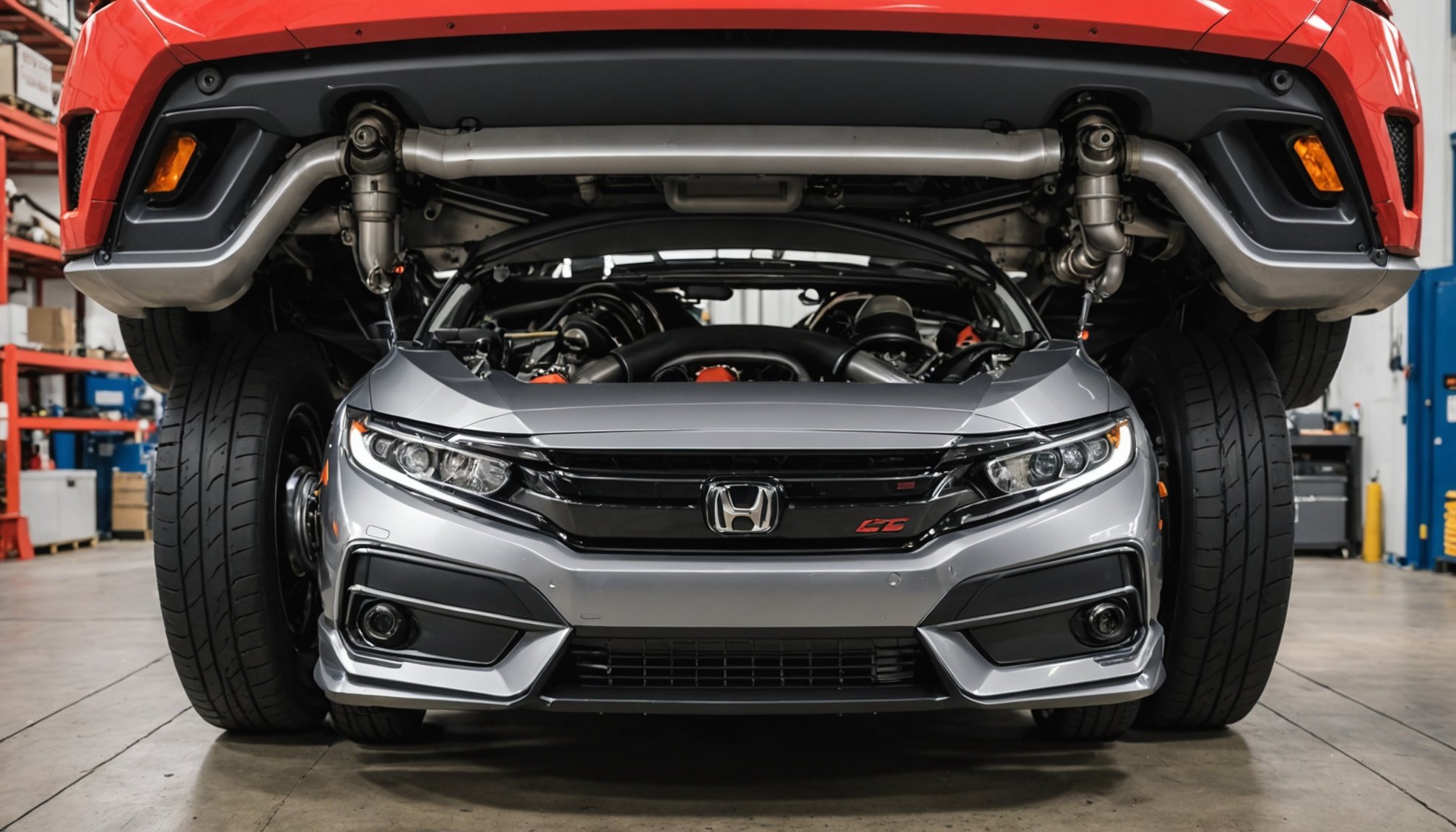Understanding Performance Exhaust Systems
Performance exhaust systems are designed to enhance a vehicle’s overall efficiency and power. These systems work by optimising the expulsion of exhaust gases from the engine, crucially impacting fuel efficiency and engine performance. Unlike standard exhausts, performance variants are engineered to minimise back pressure, enabling the engine to breathe more easily and, as a result, increase power output.
Key components that contribute to the fuel efficiency of these systems include larger diameter pipes, mandrel bends, and high-flow mufflers. These features reduce restrictions in the exhaust path, allowing a smoother flow of gases. For vehicles like the Honda Civic, upgrading from a stock to a performance exhaust system can result in noticeable differences.
This might interest you : Transform Your Fiat 500: Discover the Benefits of Custom Leather Interiors for Ultimate Luxury
Stock exhaust systems, typically designed to be cost-effective and quiet, might lack the same levels of efficiency and power enhancement. Conversely, performance exhaust systems are often constructed from higher quality materials and crafted specifically to enhance various aspects of a car’s functionality, including horsepower and torque.
For Honda Civic owners aiming to maximise performance and fuel efficiency, upgrading to a performance exhaust system offers tangible benefits. It not only improves exhaust flow but also contributes positively to the vehicle’s aesthetic and auditory appeal.
In the same genre : Unlocking Power and Sound: How an Aftermarket Exhaust System Transforms Your Audi S5
Fuel Efficiency Improvements with a Performance Exhaust
Many Honda Civic enthusiasts find that installing a performance exhaust system offers substantial fuel efficiency improvements. But how does this happen? The secret lies primarily in enhanced engine airflow. When you reduce exhaust back pressure, the engine breathes better, which often means less fuel is needed for the same power output—especially at higher speeds.
You might wonder about the specific mechanisms through which performance exhaust systems achieve such results. One of the primary factors is the reduction in exhaust restriction. By allowing spent gases to exit the engine more freely, the system reduces the power the engine needs to push out exhaust, effectively improving efficiency.
Studies have shown varied outcomes in fuel consumption changes; however, a consistent theme emerges: a well-designed performance exhaust can offer significant efficiency improvements in highway driving scenarios. For instance, tests on different models, including the acclaimed Honda Civic, often reveal improvements in miles per gallon (MPG), particularly when driving conditions favour steady speeds and low load.
By focusing on efficiency and performance gains, Honda Civic owners not only enjoy the benefits of a more responsive and powerful ride but also spend less at the pump. Investing in the right exhaust system provides both environmental and economic advantages.
Installation Guide for Performance Exhaust Systems
Installing a performance exhaust system on your Honda Civic can enhance its power and give it a meaner sound. Following a methodical approach ensures a smoother installation experience.
Tools Required for Installation
To embark on a performance exhaust installation, you will need some basic tools. These include:
- Socket wrench set
- Torque wrench
- Jack stands
- WD-40 or a similar rust penetrant for loosening stubborn bolts
Having these tools on hand before starting will make the process more efficient.
Step-by-Step Installation Process
Starting with your Honda Civic DIY project, position the car safely on jack stands. Ensure the exhaust system and pipes align correctly to avoid future leaks.
- Disconnect the old exhaust. Use the socket wrench.
- Mount the new exhaust system, beginning with the manifold.
- Secure each section with clamps or flanges, ensuring they’re properly torqued.
Regularly check alignment for optimal performance.
Common Installation Mistakes
Avoid common pitfalls in a performance exhaust installation by taking caution with tightening bolts. Over-tightening can damage the exhaust hanger. Another mistake is neglecting gasket replacement, which could lead to exhaust leaks. Prepare by ensuring all components are in place before tightening completely. This thorough approach will yield a solid and efficient exhaust setup for your vehicle.
User Testimonials and Case Studies
When evaluating the Honda Civic experiences post-exhaust installation, enthusiasts’ feedback becomes essential. User testimonials often highlight dramatic shifts in both the car’s performance and aesthetic appeal. One owner remarked, “Upgrading the exhaust transformed my Civic’s sound into a deep, assertive roar, enhancing my driving experience significantly.”
Real-world case studies present concrete performance benefits. Users frequently report an increase in horsepower, thanks to optimal airflow dynamics provided by the new exhaust. One analysis showcased a gain of approximately 10 horsepower, which might seem trivial. However, in the world of vehicles, every improvement counts toward overall driving excellence.
Interestingly, users also observe improved fuel efficiency. A driver recounted achieving around 4% better fuel consumption over long-distance driving. This highlights how performance upgrades can deliver benefits beyond mere speed and acceleration.
The comparative context between stock systems and these enhanced ones reveals that performance exhausts provide a more resonant exhaust note and potentially better torque delivery at lower RPMs. Such performance metrics underscore the practical advantages of these modifications, encouraging Civic enthusiasts to explore these aftermarket enhancements for better outcomes.
These Honda Civic experiences reflect how everyday users translate custom tweaks into tangible benefits, blending passion with performance.
Cost Analysis of Performance Exhaust Systems
When conducting a cost analysis of performance exhaust systems, it’s essential to consider several components. The performance exhaust costs can be divided into two main categories: the initial purchase and the installation expenses. The purchase price varies depending on the brand, material, and design, with stainless steel often on the higher end due to its durability and corrosion resistance. Installation costs, meanwhile, depend on local labour rates and whether modifications to your existing vehicle setup are required.
A Honda Civic pricing example illustrates that costs can range from £200 for simpler systems to over £1,000 for premium designs. However, the financial outlay can offer returns through potentially reduced fuel consumption. High-performance exhausts improve engine efficiency by allowing gases to exit faster, thereby improving fuel economy over time.
When evaluating the overall value, it’s crucial to compare this against other performance modifications. While a turbocharger might offer greater horsepower gains, it typically comes at a higher cost both upfront and in maintenance. Meanwhile, an exhaust system provides a balanced mix of performance increase and cost-effectiveness. Thus, for Honda Civic enthusiasts seeking a balance of performance and cost efficiency, investing in a performance exhaust system can be a prudent decision.
Enhancements Beyond Fuel Efficiency
When considering performance enhancements for a vehicle, there’s more than meets the eye than just fuel economy. These modifications can significantly elevate the overall vehicle performance, offering a more thrilling driving experience. Enhancements can optimize engine output, leading to a smoother, more responsive ride that car enthusiasts crave.
One notable aspect of these upgrades is their effect on the vehicle’s sound. Often, they contribute to a more refined and aggressive engine note, which can significantly enhance the auditory experience. This isn’t merely about volume – it’s about creating a symphony that reflects the power under the hood, offering an aural pleasure that complements the enhanced performance.
The relationship between exhaust modifications and overall vehicle performance is also crucial. Improved exhaust systems can decrease back pressure and increase engine efficiency, which are pivotal for boosting horsepower and torque. They not only help the car breathe better but also ensure optimal performance across different driving conditions. This ensures that every drop of fuel contributes to propulsion, rather than being wasted.
Performance enhancements thus provide a holistic improvement in your driving experience, from roaring engine sounds to seamless, powerful acceleration. These changes make each journey exhilarating, ensuring that your vehicle operates at peak efficiency.











